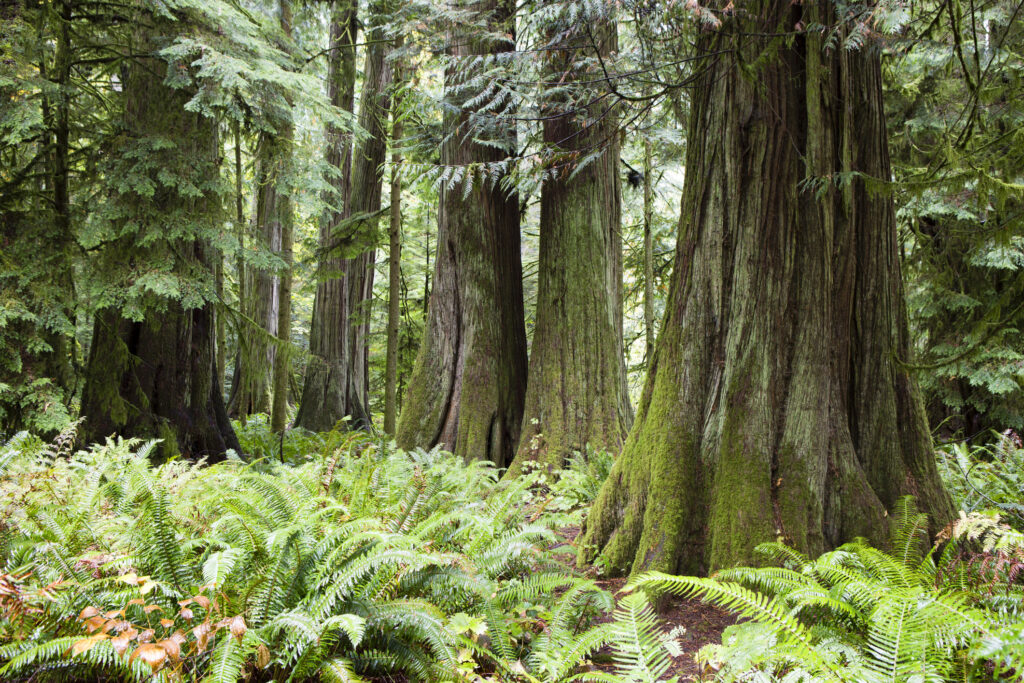An expert study authored in 2020 by Dr. Price, ecologist Dr. Rachel Holt and landscape analyst Dave Daust, found that areas in BC with the potential to grow large trees cover only three percent of the province. And only 2.7% of the trees in these areas are currently old because years of commercial logging have caused them to “dwindle considerably.”
These larger trees have been around for thousands of years; store higher amounts of carbon, are great supporters of biodiversity, and promote ecosystem health. And many of them are not protected from logging.
“Unfortunately, the most valuable old-growth forests are also the forests that are most valuable from a timber perspective,” says Dr. Holt. “So, we have to decide whether we're managing for money, or whether we're managing for ecosystem health.”
Dr. Holt is a member of the province’s independent Old-Growth Technical Advisory Panel along with Dr. Price, Dr. Merkel, Dave Daust, and Lisa Matthaus, the provincial lead for environmental group Organizing for Change.
The panel which was formed earlier this year will help the province meet the recommendations made by the Old Growth Strategic Review in 2020. These include providing maps to the public that show the status of old-growth forests in BC, recommending priority areas to temporarily defer logging in to protect rare and at-risk old-growth forests, and shifting focus from prioritizing timber to prioritizing ecosystem health.
Dr. Merkel and Al Gorley, a professional forester and former chair of the Forest Practices Board, were appointed to the Old Growth Strategic Review by the province in 2019 and tasked with reviewing BC’s old-growth forest management and recommending a new approach.
After engaging with First Nations, forestry companies, community members and other stakeholders, they made 14 recommendations for the future of BC’s old-growth forests. Dr. Merkel says the crux of these recommendations is a paradigm shift in the way BC manages its old-growth forests—moving away from managing for timber and beginning to manage for ecosystem health.
Maps produced by Dr. Holt, Dr. Price and Dave Daust show that in almost all areas of the province, old-growth forests are under threat and some are at risk of being logged in the next 5–10 years. In their study, they call on the province to immediately implement a moratorium on harvesting:
- Old and mature forest in ecosystems with less than 10 percent of old forest remaining
- Areas with the potential for resilience such as Walbran on Vancouver Island
- Irreplaceable old forest including ancient or very old forest
"The bottom line is, we cannot keep logging things that are completely irreplaceable and globally valuable,” Dr. Holt says. “That really is the central piece of it: we have to log less and we have to log better.”
The Old Growth Strategic Review also recommends prioritizing collaborations with Indigenous leaders, organizations, and communities. In the past, land use planning has not always included Indigenous voices. The report stresses that “BC’s Indigenous communities will be key players as one of the most important participants in our future forest management system.”
Recently, the province accepted a request by the Pacheedaht, Ditidaht, and Huu-ay-aht First Nations to pause old-growth logging in the Fairy Creek and Central Walbran areas on southwest Vancouver Island for two years while they create their own plans for stewardship of their territories.
The Hišuk ma c̕awak Declaration which was signed on June 4 asserts the right of the three nations to decide how their old-growth forests are managed, stating: “For most of the past 150 years we have watched others decide what is best for our lands, for our waters and for our people. That time is over.”
BC’s last Old Growth Strategic Review was prepared in the early 1990s and Dr. Merkel shares that almost none of the recommendations in that report were implemented.
The recommendations made in our current Old Growth Strategic Review have not yet been fully implemented but Dr. Merkel is hopeful for change as we wait for further government action. He explains that a paradigm shift such as this—a shift in the way we’ve done things for centuries—is paramount to our futures, but will take time.
Wanna learn about the different ecosystems in BC?
Check out this resource for interesting activities that will teach you about BC’s unique coastal temperate rainforest, including our biomes and old-growth forests.

